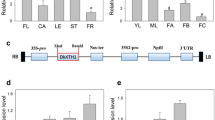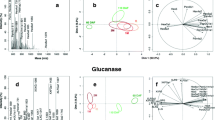Abstract
The ripening-related pepper endo-1,4-β-D-glucanase (EGase) CaCel1 was over-expressed in transgenic tomato plants under the control of the constitutive 35S promoter to investigate the effects on plant growth and fruit softening of high levels of a potential cell wall-degrading activity. In transgenic fruit, recombinant CaCel1 protein was associated with a high-salt putative cell wall fraction, and extractable CMCase activity was increased by up to 20-fold relative to controls. However, the effects of high levels of EGase activity on fruit cell wall metabolism were relatively small. The largest consequence observed was a decrease of up to 20% in the amount of matrix glycans in a 24% KOH-soluble fraction consisting of polysaccharides tightly bound to cellulose. This decrease was confined to polysaccharides other than xyloglucan, did not affect the size distribution of remaining molecules, and was not correlated with a corresponding increase in glycans in a 4% KOH-soluble fraction loosely bound to cellulose, suggesting that the missing polymers had been degraded to fragments small enough to be lost from the extracts. The amount of matrix glycans in the 4% KOH-soluble fraction was not substantially changed, but the size distribution showed a small relative increase in the amount of polymers in a peak eluting close to a linear dextran marker of 71 kDa. This could be due either to an increase in the amount of polymers of this size, or to a loss from the extract of other polymers present in peaks of higher molecular weight. Transgenic fruit were not softer than controls but appeared the same or slightly firmer at both green and red developmental stages, and no differences in plant vegetative growth were observed. CaCel1 did not cause depolymerization of tomato fruit xyloglucan in vivo, but differences in the amount or molecular weight profile of other matrix glycans were observed. The data suggest that degradation of a proportion of matrix glycans other than xyloglucan does not result in fruit softening, and that fruit softening is not limited by the amount of EGase activity present during ripening.
Similar content being viewed by others
References
Bonghi, C., Ferrarese, L., Ruperti, B., Tonutti, P. and Ramina, A. 1998. Endo-?-1,4-glucanases are involved in peach fruit growth and ripening, and regulated by ethylene. Physiol. Plant. 102: 346–352.
Brummell, D.A. and Harpster, M.H. 2001. Cell wall metabolism in fruit softening and quality and its manipulation in transgenic plants. Plant Mol. Biol. 47: 311–340.
Brummell, D.A., Lashbrook, C.C. and Bennett, A.B. 1994. Plant endo-1,4-?-D-glucanases: structure, properties, and physiological function. In: M.E. Himmel, J.O. Baker and R.P. Overend (Eds) Enzymatic Conversion of Biomass for Fuels Production (American Chemical Society Symposium Series 566), American Chemical Society, Washington DC, pp. 100–129.
Brummell, D.A., Hall, B.D. and Bennett, A.B. 1999a. Antisense suppression of tomato endo-1,4-?-glucanase Cel2 mRNA accumulation increases the force required to break fruit abscission zones but does not affect fruit softening. Plant Mol. Biol. 40: 615–622.
Brummell, D.A., Harpster, M.H., Civello, P.M., Palys, J.M., Bennett, A.B. and Dunsmuir, P. 1999b. Modification of expansin protein abundance in tomato fruit alters softening and cell wall polymer metabolism during ripening. Plant Cell 11: 2203–2216.
Carpita, N.C. and Gibeaut, D.M. 1993. Structural models of primary cell walls in flowering plants: consistency of molecular structure with the physical properties of the walls during growth. Plant J. 3: 1–30.
Christoffersen, R.E., Tucker, M.L. and Laties, G.G. 1984. Cellulase gene expression in ripening avocado fruit: the accumulation of cellulase mRNA and protein as demonstrated by cDNA hybridization and immunodetection. Plant Mol. Biol. 3: 385–391.
Dai, Z., Hooker, B.S., Anderson, D.B. and Thomas, S.R. 2000. Improved plant-based production of E1 endoglucanase using potato: expression optimization and tissue targeting. Mol. Breed. 6: 277–285.
Dubois, M., Gilles, K.A., Hamilton, J.K., Rebers, P.A. and Smith, F. 1956. Colorimetric method for determination of sugars and related substances. Anal. Chem. 28: 350–356.
Dunsmuir, P., Bond, D., Lee, K., Gidoni, D. and Townsend, J. 1987. The expression of introduced genes in regenerated plants. In: S.B. Gelvin and R.A. Schilperoort (Eds) Plant Molecular Biology Manual, Kluwer Academic Publishers, Dordrecht, Netherlands, pp. 45–59.
Ferrarese, L., Trainotti, L., Moretto, P., Polverino de Laureto, P., Rascio, N. and Casadoro, G. 1995. Differential ethyleneinducible expression of cellulase in pepper plants. Plant Mol. Biol. 29: 735–747.
Firoozabady, E., Moy, Y., Tucker, W., Robinson, K. and Gutterson, N. 1995. Efficient transformation and regeneration of carnation cultivars using Agrobacterium. Mol. Breed. 1: 283–293.
Gonzalez-Bosch, C., Brummell, D.A. and Bennett, A.B. 1996. Differential expression of two endo-1,4-?-glucanase genes in pericarp and locules of wild-type and mutant tomato fruit. Plant Physiol. 111: 1313–1319.
Harpster, M.H., Townsend, J.A., Jones, J.D.G., Bedbrook, J. and Dunsmuir, P. 1988. Relative strengths of the 35S cauliflower mosaic virus, 1', 2', and nopaline synthase promoters in transformed tobacco, sugarbeet, and oilseed rape callus tissue. Mol. Gen. Genet. 212: 182–190.
Harpster, M.H., Lee, K.Y. and Dunsmuir, P. 1997. Isolation and characterization of a gene encoding endo-?-1,4-glucanase from pepper (Capsicum annuum L.). Plant Mol. Biol. 33: 47–59.
Harpster, M.H., Brummell, D.A. and Dunsmuir, P. 1998. Expression analysis of a ripening-specific, auxin-repressed endo-1,4-?-glucanase gene in strawberry. Plant Physiol. 118: 1307–1316.
Harpster, M.H., Brummell, D.A. and Dunsmuir, P. 2002. Suppression of a ripening-related endo-1,4-?-glucanase in transgenic pepper fruit does not prevent depolymerization of cell wall polysaccharides during ripening. Plant Mol. Biol. 33: 47–59.
Hatfield, R. and Nevins, D.J. 1986. Characterization of the hydrolytic activity of avocado cellulase. Plant Cell Physiol. 27: 541–552.
Hayashi, T., Wong, Y.-S. and Maclachlan, G. 1984. Pea xyloglucan and cellulose. II. Hydrolysis by pea endo-1,4-?-glucanase. Plant Physiol. 75: 605–610.
Higgins, D.G., Bleasby, A.J. and Fuchs, R. 1992. CLUSTAL V: improved software for multiple sequence alignment. Comput. Appl. Biosci. 8: 189–191.
Huber, D.J. 1985. A possible role for cellulose and Cx-cellulase activity in locular gel formation in tomato fruit. HortScience 20: 442–443.
Huber, D.J. and O'Donoghue, E.M. 1993. Polyuronides in avocado (Persea americana) and tomato (Lycopersicon esculentum) fruits exhibit markedly different patterns of molecular weight downshifts during ripening. Plant Physiol. 102: 473–480.
Kalaitzis, P., Hong, S.-B., Solomos, T. and Tucker, M.L. 1999. Molecular characterization of a tomato endo-?-1,4-glucanase gene expressed in mature pistils, abscission zones and fruit. Plant Cell Physiol. 40: 905–908.
Kooiman, P. 1960. A method for the determination of amyloid in plant seeds. Recl. Trav. Chim. Pays-Bas 79: 675–678.
Lashbrook, C.C., Gonzalez-Bosch, C. and Bennett, A.B. 1994. Two divergent endo-?-1,4-glucanase genes exhibit overlapping expression in ripening fruit and abscising flowers. Plant Cell 6: 1485–1493.
Lashbrook, C.C., Giovannoni, J.J., Hall, B.D., Fischer, R.L. and Bennett, A.B. 1998. Transgenic analysis of tomato endo-?-1,4-glucanase gene function. Role of cel1 in floral abscission. Plant J. 13: 303–310.
Levy, S., Maclachlan, G. and Staehelin, L.A. 1997. Xyloglucan sidechains modulate binding to cellulose during in vitro binding assays as predicted by conformational dynamics simulations. Plant J. 11: 373–386.
Maclachlan, G. and Brady, C. 1992. Multiple forms of 1,4-?-glucanase in ripening tomato fruits include a xyloglucanase activatable by xyloglucan oligosaccharides. Aust. J. Plant Physiol. 19: 137–146.
Maclachlan, G. and Brady, C. 1994. Endo-1,4-?-glucanase, xyloglucanase and xyloglucan endo-transglycosylase activities versus potential substrates in ripening tomatoes. Plant Physiol. 105: 965–974.
Matsumoto, T., Sakai, F. and Hayashi, T. 1997. A xyloglucanspecific endo-1,4-?-glucanase isolated from auxin-treated pea stems. Plant Physiol. 114: 661–667.
McCormick, S., Niedermeyer, J., Fry, J., Barnason, A., Horsch, R. and Fraley, R. 1986. Leaf disc transformation of cultivated tomato (L. esculentum) using Agrobacterium tumefaciens. Plant Cell Rep. 5: 81–84.
Nakamura, S. and Hayashi, T. 1993. Purification and properties of an extracellular endo-1,4-?-glucanase from suspension-cultured poplar cells. Plant Cell Physiol. 34: 1009–1013.
O'Donoghue, E.M. and Huber, D.J. 1992. Modification of matrix polysaccharides during avocado (Persea americana) fruit ripening: an assessment of the role of Cx-cellulase. Physiol. Plant. 86: 33–42.
O'Donoghue, E.M., Huber, D.J., Timpa, J.D., Erdos, G.W. and Brecht, J.K. 1994. Influence of avocado (Persea americana) Cxcellulase on the structural features of avocado cellulose. Planta 194: 573–584.
Ohmiya, Y., Takeda, T., Nakamura, S., Sakai, F. and Hayashi, T. 1995. Purification and properties of a wall-bound endo-1,4-?-glucanase from suspension-cultured poplar cells. Plant Cell Physiol. 36: 607–614.
Ohmiya, Y., Samejima, M., Shiroishi, M., Amano, Y., Kanda, T., Sakai, F. and Hayashi, T. 2000. Evidence that endo-1,4-?-glucanases act on cellulose in suspension-cultured poplar cells. Plant J. 24: 147–158.
Pauly, M., Albersheim, P., Darvill, A. and York,W.S. 1999. Molecular domains of the cellulose/xyloglucan network in the cell walls of higher plants. Plant J. 20: 629–639.
Sakurai, N. and Nevins, D.J. 1992. Evaluation of stress-relaxation in fruit tissue. HortTechnology 2: 398–402.
Sambrook, J., Fritsch, E.F. and Maniatis, T. 1989. Molecular Cloning: A Laboratory Manual, 2nd ed. Cold Spring Harbor Laboratory Press, Plainview, NY.
Tabuchi, A., Mori, H., Kamisaka, S. and Hoson, T. 2001. A new type of endo-xyloglucan transferase devoted to xyloglucan hydrolysis in the cell wall of azuki bean epicotyls. Plant Cell Physiol. 42: 154–161.
Truelsen, T.A. and Wyndaele, R. 1991. Cellulase in tobacco callus: regulation and purification. J. Plant Physiol. 139: 129–134.
Villavicencio, L., Blankenship, S.M., Sanders, D.C. and Swallow, W.H. 1999. Ethylene and carbon dioxide production in detached fruit of selected pepper cultivars. J. Am. Soc. Hort. Sci. 124: 402–406.
Ziegler, M.T., Thomas, S.R. and Danna, K.J. 2000. Accumulation of a thermostable endo-1,4-?-D-glucanase in the apoplast of Arabidopsis thaliana leaves. Mol. Breed. 6: 37–46.
Author information
Authors and Affiliations
Rights and permissions
About this article
Cite this article
Harpster, M.H., Dawson, D.M., Nevins, D.J. et al. Constitutive overexpression of a ripening-related pepper endo-1,4-β-glucanase in transgenic tomato fruit does not increase xyloglucan depolymerization or fruit softening. Plant Mol Biol 50, 357–369 (2002). https://doi.org/10.1023/A:1019888129013
Issue Date:
DOI: https://doi.org/10.1023/A:1019888129013




